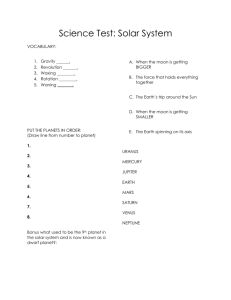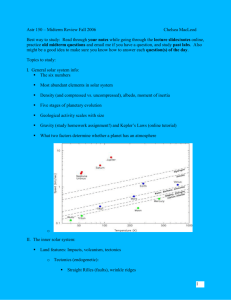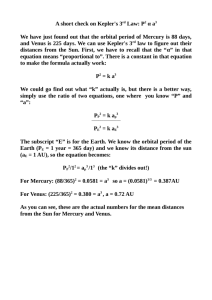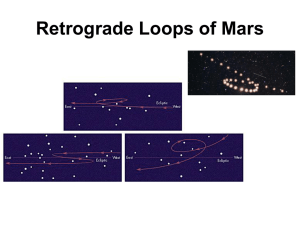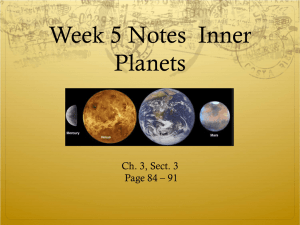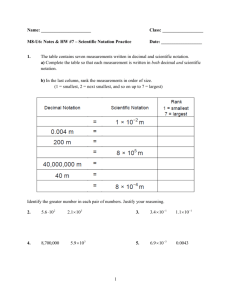Solutions of Homework# 4 Chapter 8 : Review & Discussion Chapter
advertisement
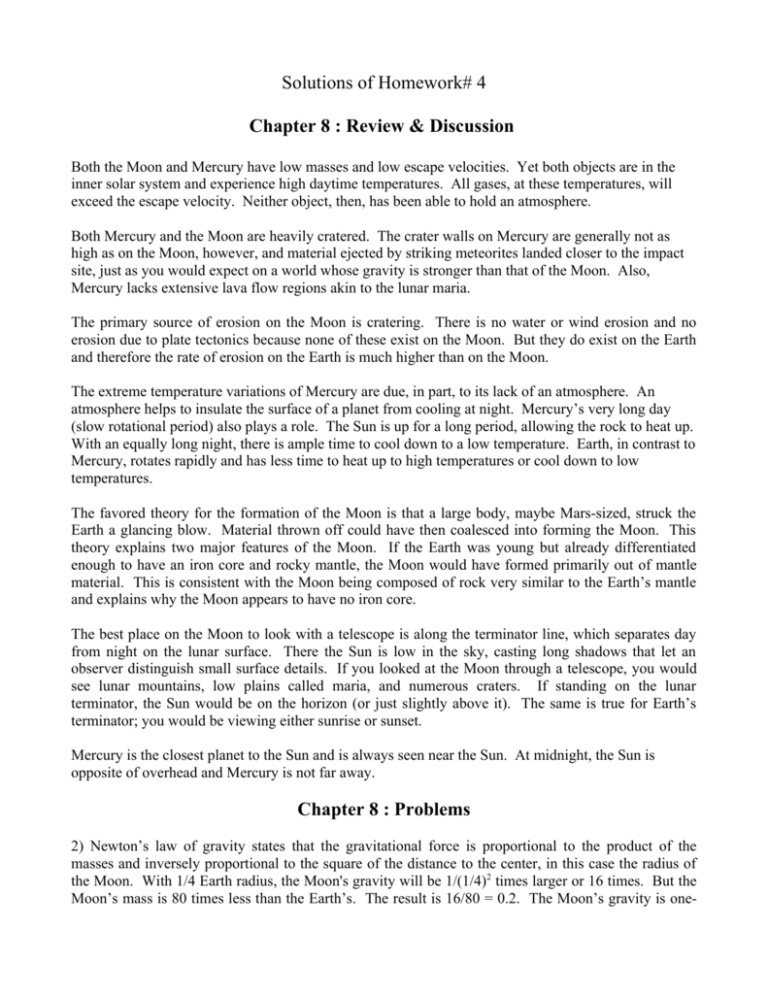
Solutions of Homework# 4 Chapter 8 : Review & Discussion Both the Moon and Mercury have low masses and low escape velocities. Yet both objects are in the inner solar system and experience high daytime temperatures. All gases, at these temperatures, will exceed the escape velocity. Neither object, then, has been able to hold an atmosphere. Both Mercury and the Moon are heavily cratered. The crater walls on Mercury are generally not as high as on the Moon, however, and material ejected by striking meteorites landed closer to the impact site, just as you would expect on a world whose gravity is stronger than that of the Moon. Also, Mercury lacks extensive lava flow regions akin to the lunar maria. The primary source of erosion on the Moon is cratering. There is no water or wind erosion and no erosion due to plate tectonics because none of these exist on the Moon. But they do exist on the Earth and therefore the rate of erosion on the Earth is much higher than on the Moon. The extreme temperature variations of Mercury are due, in part, to its lack of an atmosphere. An atmosphere helps to insulate the surface of a planet from cooling at night. Mercury’s very long day (slow rotational period) also plays a role. The Sun is up for a long period, allowing the rock to heat up. With an equally long night, there is ample time to cool down to a low temperature. Earth, in contrast to Mercury, rotates rapidly and has less time to heat up to high temperatures or cool down to low temperatures. The favored theory for the formation of the Moon is that a large body, maybe Mars-sized, struck the Earth a glancing blow. Material thrown off could have then coalesced into forming the Moon. This theory explains two major features of the Moon. If the Earth was young but already differentiated enough to have an iron core and rocky mantle, the Moon would have formed primarily out of mantle material. This is consistent with the Moon being composed of rock very similar to the Earth’s mantle and explains why the Moon appears to have no iron core. The best place on the Moon to look with a telescope is along the terminator line, which separates day from night on the lunar surface. There the Sun is low in the sky, casting long shadows that let an observer distinguish small surface details. If you looked at the Moon through a telescope, you would see lunar mountains, low plains called maria, and numerous craters. If standing on the lunar terminator, the Sun would be on the horizon (or just slightly above it). The same is true for Earth’s terminator; you would be viewing either sunrise or sunset. Mercury is the closest planet to the Sun and is always seen near the Sun. At midnight, the Sun is opposite of overhead and Mercury is not far away. Chapter 8 : Problems 2) Newton’s law of gravity states that the gravitational force is proportional to the product of the masses and inversely proportional to the square of the distance to the center, in this case the radius of the Moon. With 1/4 Earth radius, the Moon's gravity will be 1/(1/4)2 times larger or 16 times. But the Moon’s mass is 80 times less than the Earth’s. The result is 16/80 = 0.2. The Moon’s gravity is one- fifth the gravity of the Earth. A kilogram on Earth weighs about 2.2 pounds; 150 kg × 2.2 lbs/kg = 330 lbs. This is the weight on Earth of the astronaut plus backpack and spacesuit. On the Moon, the astronaut would weigh 1/5 of this, or 66 lbs. 5. The Sun appears to be about half a degree from Earth or 0.53°. Mercury is at 0.31 A.U. and 0.47 A.U. from the Sun at perihelion and aphelion. The Sun will appear 1 / 0.31 and 1 / 0.47 times larger. This becomes 3.2 × 0.53 = 1.7° and 2.1 × 0.53 = 1.1°. 6. Use the angular diameter formula from More Precisely 1–4. Angular units will be in seconds of arc, not degrees. For the Moon, d = 380,000 (0.05 / 206,000) = 0.092 km or 92 m. Mercury, at a distance of 0.47 A.U., from the Sun, will be 0.53 A.U. from Earth, or 80 million km. This gives d = 80,000,000 (0.05 / 206,000) = 19 km. 9. To obtain the orbital distance at perihelion and aphelion, refer to More Precisely 2-. For Mercury we have R p = a ( 1- e ) = .39 ( 1 − .206 ) = .31 AU = 4.64 ×1010 m and R a = a ( 1 + e ) = .39 ( 1 + .206 ) = .47 AU = 7.1×1010 m θπ R 2 Now, the area, A, of a sector of a circle is given by A = , where R is the radius of the circle, 360o orbital distance, and θ is the angle swept out by the orbiting object. First, find the value for this area based on the mean orbital speed and mean orbital radius. Mercury completes one full orbit in 88 days and has a mean orbital radius of 5.79x107 km. In one day, then, the area swept out by 2 1 1 2 × π ( R mean ) = × π ( 5.79 × 107 km ) = 1.2 ×1014 km 2 . Kepler’s 2nd law states mercury will be 88 88 that this area will constant over any two equal time periods as a planet orbits the Sun. θπ R p 2 So, over a one day time period when Mercury is at perihelion, we have 1.2 ×1014 km 2 = , 360o 360o × ( 1.2 ×1014 km 2 ) = 6.4o /day . the angle swept out in one day will then be θ p = 2 7 π × ( 4.64 ×10 km ) Similarly, for one day at aphelion we have θ a = 360o × ( 1.2 × 1014 km 2 ) π × ( 7.1×10 km ) 7 2 = 2.7o /day . 11) Towards the end of More Precisely 8–1, the situation for Mercury is given. Its average molecular speed of 0.8 km/s must be multiplied by 6, = 4.8 km/s, to get the escape speed needed to keep a nitrogen atmosphere. The current speed is 4.2 km/s. The speed is proportional to the square root of the planet’s mass. Square both sides of this equation and form a proportion of new / old. (4.8 / 4.2)2 = New mass / Original mass = 1.31. The new mass is 31% larger than the current mass or 4.3×1023 kg. Chapter 9 : Review & Discussion 2. Since Venus is an inner planet, it will never be found too far from the Sun. However, it is much easier to see than Mercury, having an orbit almost twice the size of Mercury’s. 7. At one time, Venus was thought to have a warm, tropical environment. In the 1950s, radio observations of Venus measured its thermal emission. The radiation emitted by Venus has a Planck curve spectrum characteristic of a temperature near 600 K. It was hardly a tropical, habitable planet. 9. The atmosphere of Venus has a total mass about 90 times greater than that of Earth and extends to a much greater altitude than that of Earth’s atmosphere. 90 percent of the Earth’s atmosphere lies within about 10 km of the surface, compared with 50 km on Venus. The surface temperature and pressure of Venus’s atmosphere are much greater than Earth’s. 11. Venus has both a very thick atmosphere and one mostly composed of carbon dioxide. Carbon dioxide is a very effective greenhouse gas, trapping infrared light within the atmosphere and raising the temperature. This, in combination with the largeness of the atmosphere, has produced a very large greenhouse effect and a resulting high temperature. On Earth, almost all of the water vapor and carbon dioxide present in the planet’s early atmosphere quickly became part of the surface of the planet, in the oceans or in the surface rocks. On Venus, the temperature may have been so high that no oceans condensed, in which case water vapor and carbon dioxide remained in the atmosphere. The carbon dioxide was never incorporated in the crust of Venus. The water was slowly broken down by solar ultraviolet light into hydrogen and oxygen. The hydrogen escaped into space and the oxygen formed oxides of sulfur and carbon. 13. Its climate might be similar to Earth’s. An important point to remember, however, is that Venus is a smaller planet with a lower surface gravity. It might not have been able to hold onto as much of an atmosphere as the Earth. 15. There is a strong deficiency in small impact craters on Venus, due to its atmosphere destroying meteoroids smaller than about 1 km. The smaller impact craters show evidence of the meteoroid being shattered prior to impact. There is also a deficiency in larger craters, but this is likely due to the surface of Venus being resurfaced by volcanic activity. 18. The dynamo model for the production of planetary magnetic fields requires both an iron-rich core and a relatively rapid rate of rotation. Venus lacks the rapid rotation and therefore does not appear to produce a magnetic field. Actually, the fact that it does not have a magnetic field strongly suggests that the dynamo model is correct. Chapter 9 : Problems 3. When Venus is brightest, it is 0.47 A.U. × 1.5×108 km/A.U. = 7.05×107 km distant. Dividing by the speed of light gives 235 s. Multiplying by 2 for a round trip gives 470 s or 7 minutes and 50 seconds. When Venus is closest, 0.28 A.U., this time will be reduced by the ratio of the distances; (0.28 / 0.43) × 430 = 280 s or 4 minutes and 40 seconds. 7. At closest approach, Earth is 0.28 A.U. or 4.2x107 km distant. The tidal gravitational acceleration, at, on Venus (between center and surface) due to Earth at closest approach is given by at = GM Earth R 6.673 × 10-11 × 5.97 ×1024 × 6.05 ×106 = = 3.25 × 10−11 m/s 2 , 3 3 10 r ( 4.2 ×10 ) where r is the distance between Venus and Earth and R is the radius of Venus, 6.05x106 m. The surface gravity on Venus is known to be 8.87 m/s2. Therefore, the tidal gravitational acceleration due to Earth is about a factor of 3.7x10-12 that of Venus’s surface gravity. For the Sun's tidal effect on Venus: at = GM Sun R 6.673 × 10-11 ×1.99 × 1030 × 6.05 × 106 = = 6.38 × 10−7 m/s 2 , 11 3 r3 ( 1.08 ×10 ) where r is the distance between Venus and the Sun. This is 7.2x10-8 times Venus’s surface gravity. 11. The circumference of Venus is 2 π 6,051 km = 38,020 km. The distance covered in 4 days or 96 hours gives 400 km/hr. A kilometer is about 5/8 of a mile, so this is about 250 miles per hour. 13. The amount of radiation emitted per square meter is proportional to the fourth power of the temperature. (730/300)4 = 35, so Venus radiates 35 times more than the Earth. 15. Use Kepler’s third law in the form given in More Precisely 2–3. The major axis will be the total of 6051 + 294 = 6345 km and 6051 + 8543 = 14594 km. The semi-major axis is 10,470 km or 1.05 × 107 m. ( 1.05 ×10 ) 7 3 P = 2π 6.7 ×10−11 × 4.87 × 1024 P = 11,800 s or 200 minutes The new semi-major axis is 6411 km. The new period is 94 minutes. Chapter 10 : Review & Discussion 3. For a century, there was speculation that intelligent life had constructed irrigation canals on Mars. What did the “canals” turn out to be? The canals were just figments of the imagination of those who believed canals had to exist. Percival Lowell mistakenly believed canals had been discovered by Italian astronomer and jumped to the conclusion that there was life on Mars. He built and funded the operation of an entire observatory dedicated to their study and further discovery. Any canal that might have existed was known by astronomers to be impossible to see from Earth; it would have to be enormous in size and contrary to the fact that there was little evidence of water on Mars. All this has had a happy ending though. The Lowell Observatory in Flagstaff, Arizona became an important research facility for astronomers and has been productive for many years. 5. Describe the two Martian polar caps, their seasonal and permanent composition, and the differences between them. The two polar caps are actually composed of two separate caps each: the seasonal cap and the residual cap. The seasonal cap has a composition of frozen carbon dioxide. They grow during the winter and diminish during the summer. The southern residual cap has a composition of frozen carbon dioxide, with some frozen water. The northern residual cap is almost 3 times larger than the southern cap and is composed mostly frozen water. 9. Why couldn’t you breathe on Mars? There’s not much to breathe on Mars. The atmospheric density is about one hundredth that of the Earth’s atmosphere. Even if you breathe such a thin atmosphere, it wouldn’t do you much good; it is composed mostly of carbon dioxide. 10. What is the evidence that water once flowed on Mars? River and stream channels are certain evidence that water once flowed on the surface of Mars. The same might be said for similar features in some of Earth’s most arid deserts, where water may flow for only a matter of during an entire year. But the water flow on Mars is not seasonal as it is on Earth. 14. How were the masses of Mars’s moons measured, and what did these measurements tell us about their origin? The Viking orbiters measured the gravitational effects of both moons and estimated their masses. Their densities are about 2 g/cm3, which is rather low for rocky bodies and suggest that they were captured by Mars and did not form along with Mars. 17. How would Earth look from Mars? Earth, at its closest approach to Mars, would appear about twice the size that Mars does from the Earth. Earth would be seen as an inner planet from Mars and would appear to go through phases. At closest approach (Mars in opposition and perihelion), the Earth would look quite dark because the night side would be facing Mars. At better angles, Earth would have a variety of colors; blue, brown, and whites of the oceans, continents, and cloud and ice regions. 19. Since Mars has an atmosphere, and it is composed mostly of a greenhouse gas, why isn’t there a significant greenhouse effect to warm its surface? There is plenty (relative abundance) of carbon dioxide to create a greenhouse effect, just no significant atmosphere to be warmed by it. The atmosphere of Mars is less than one percent that of the Earth, and produces little insulation to keep the surface warm. Chapter 10 : Problems 1. Use the formula for synodic period from More Precisely 7–3. 1 1 1 = − S 365.26 686.9 S = 780.0 days 3. This can be solved graphically or by using simple trigonometry. If θ is the angle of greatest elongation, then sin(θ) = 1/1.5 and θ = 42°. 8. The circumference of Mars is 2π × 3397 = 21,340 km. At a speed of 150 km/h, it will take 21,340 / 150 = 142 h or almost 6 Earth days. 12. 10 million metric tons of water, with 1000 kg per metric ton, gives 1010 kg. The density of water is 1,000 km/m3. Dividing the mass of water by its density will give its volume, or 107 m3. This is the volume that flows each second. The cross-sectional area of the outflow channel is 10,000 m × 100 m = 106 m2. Divide this into the volume flow rate: 107 m3/s / 106 m2 = 10 m/s. This is about 23 miles per hour. 15. Referring to More Precisely 1-3, we have the angular size of Phobos to be: true diameter × 57.3o 28 km × 57.3o angular diameter = = = 0.17o = 10.3' distance 9378 km For Deimos, we have: angular diameter = true diameter × 57.3o 16 km × 57.3o = = 0.04o = 2.3' distance 23, 459 km Since Mars is about 1.5 A.U. away from the Sun, the Sun will appear 1.5 times smaller. From Earth the Sun is about 30' in diameter; from Mars it will be 20' across. This is much bigger than the angular size of either moon.




